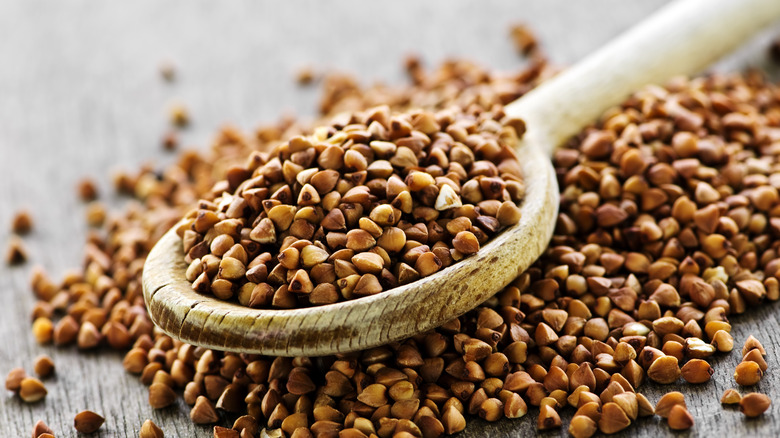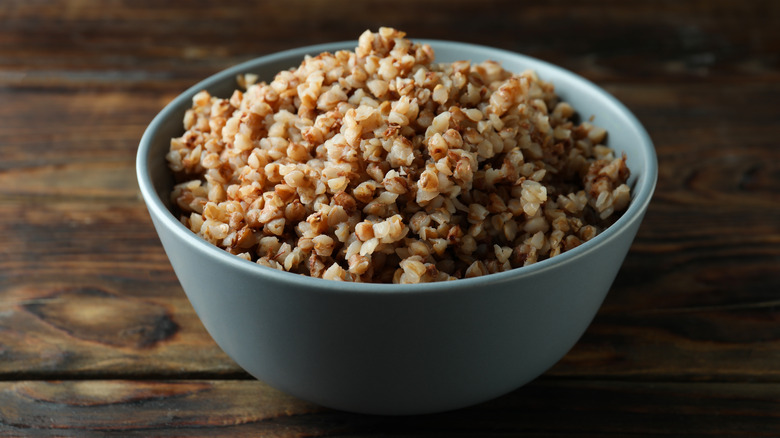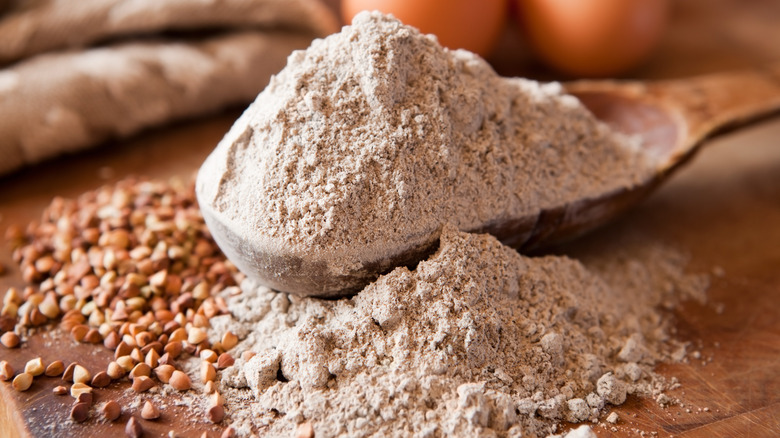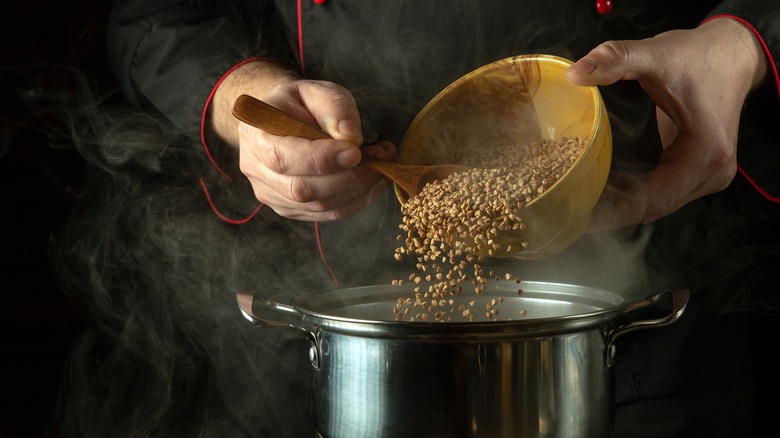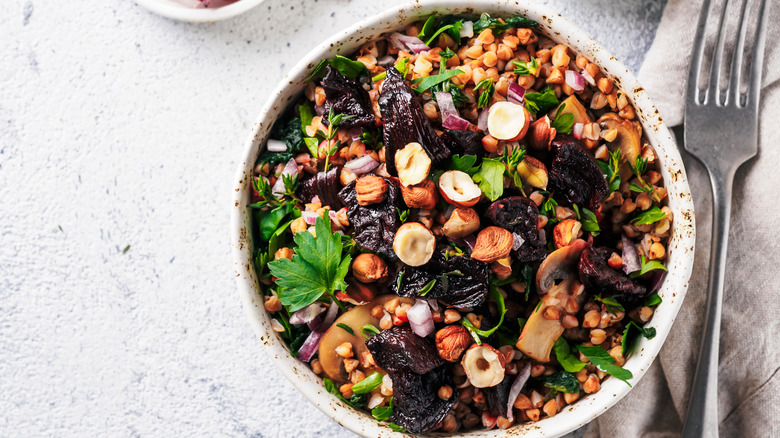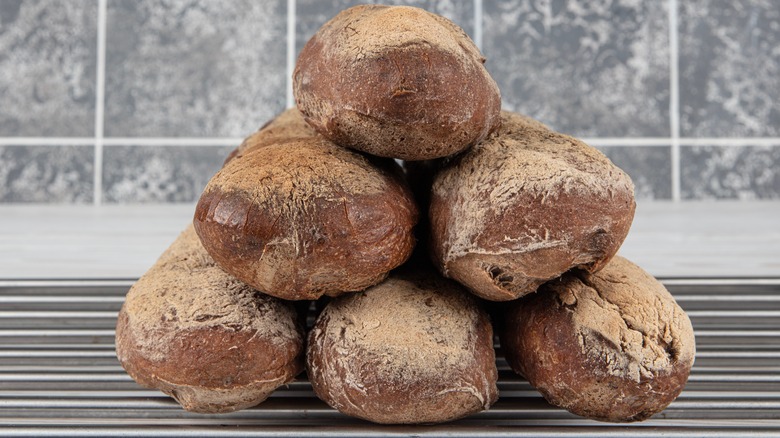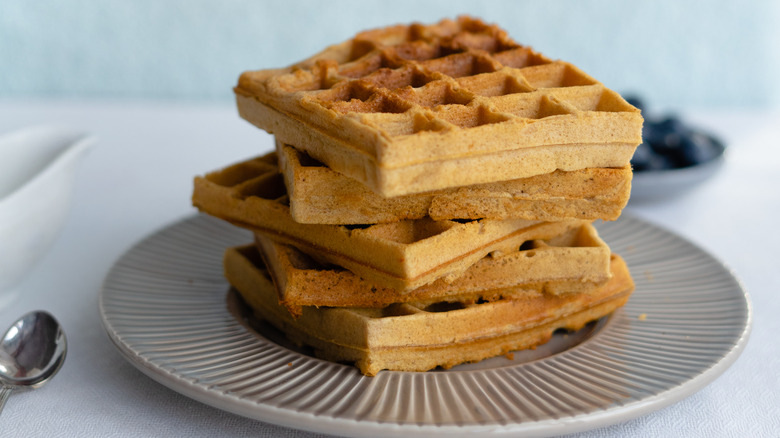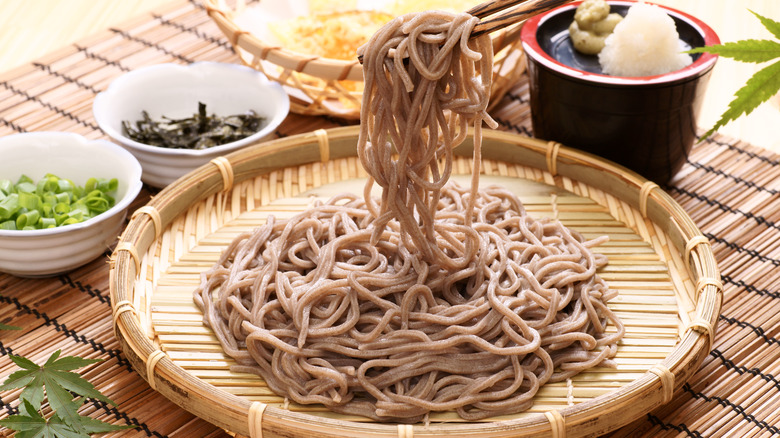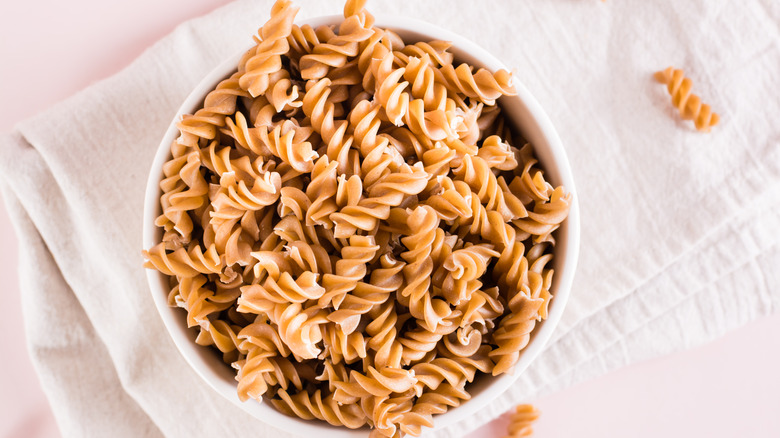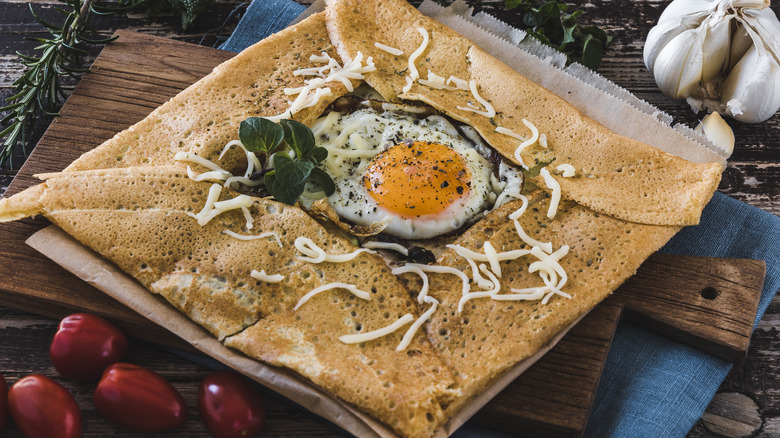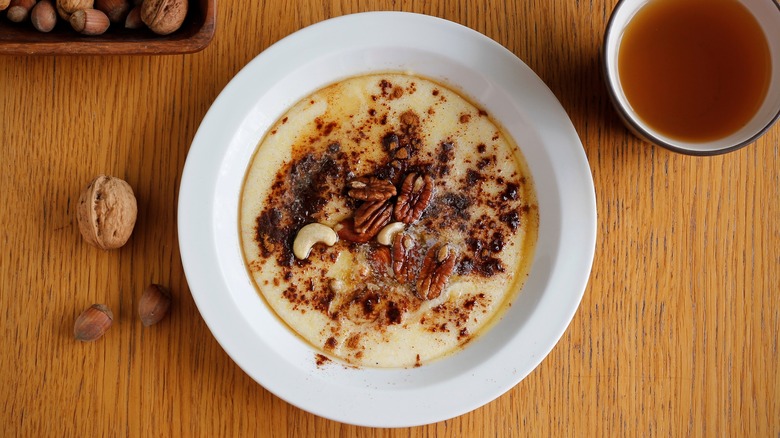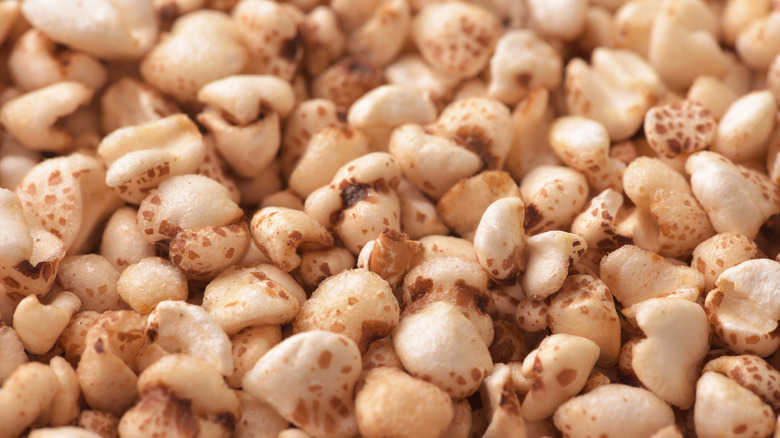11 Expert-Approved Reasons To Start Cooking With Buckwheat Again
Buckwheat is one of those ingredients that few people cook with regularly anymore. In fact, many folks wouldn't even know what to do with this hearty seed. But, perhaps it's time to bring it back into our kitchens and onto our plates. After all, a varied diet is important for nutrition — not to mention that buckwheat is versatile and delicious.
I have experience cooking with buckwheat, but I wanted to get into the nitty-gritty, so I spoke with three culinary experts who love cooking with this ingredient. For starters, I interviewed Kaytee Hadley, MS, RDN, IFMCP, registered dietitian and nutrition partner with Great River Organic Milling to give her expert opinion on the health aspects of buckwheat. I also spoke to chef Davin Waite, owner of The Plot and Elaine Gordon, author of food blog Eating by Elaine.
With these expert opinions on everything from cooking methods to nutritional credentials, I came up with 11 reasons you should start cooking with buckwheat again. Whether in the form of groats, flour, noodles, or pasta, there are so many tasty and creative ways to use this seed that acts like a grain. So, pick up some buckwheat and get creative in the kitchen.
Buckwheat is a nutritional powerhouse
You might be wondering what buckwheat is and if it's nutritious. Well, one of the first reasons you might want to start cooking with it is that it's so good for you. "Buckwheat is a nutritious whole grain with 2 grams of heart-healthy fiber and 6 grams of filling protein in a ¼ cup serving, which makes about ¾ cup once cooked," says dietitian Kaytee Hadley. But, what does this mean in real terms? "Buckwheat's protein plus fiber combo may help your blood sugar stay steady after meals and keep you feeling full for longer," she says.
But, that's not where the nutritional benefits stop. Hadley tells us that buckwheat seeds also have more antioxidants and minerals compared to grains. She notes that this makes it a good choice for fighting inflammation and generally providing nourishment for your body.
Since his restaurant, The Plot, focuses on fresh produce, nutrition is also something Chef Davin Waite thinks about when planning his menu. He notes that the fiber in buckwheat is important for digestive health. "As we learn more about gut health and its connection to mental health, this is definitely something we consider when planning a menu," he remarks. He also appreciates that buckwheat is high in unsaturated fatty acids, and this plays a part in promoting heart health and lowering cholesterol.
Buckwheat is gluten-free
"Buckwheat is naturally gluten-free," explains Kaytee Hadley. And, this is one of the reasons why some people are drawn to using it. Despite the "wheat" in its name, it isn't related to wheat at all and is actually a seed, not a grain. It's often called a pseudo-cereal, which means it's cooked and eaten like a cereal grain but doesn't grow in the same way or belong to the same family. Quinoa is another example of a pseudo-cereal.
While there's nothing wrong with eating gluten, if you can, allergies and intolerances to gluten are fairly common. This ranges from celiac disease, which is a serious autoimmune condition that causes the immune system to attack the small intestine when sufferers eat gluten, to less serious intolerances that leave people feeling bloated after consuming wheat and other gluten-containing grains.
Then, some people might not be allergic or intolerant to gluten but looking to diversify their diets. If you end up eating regular bread, pasta, and wheat noodles with a lot of your meals, this will limit the range of nutrients you get, so it's always good to branch out. Whatever a person's reasons for avoiding gluten, buckwheat is a versatile alternative to wheat. You can use it for baking, cook it as an alternative to grains, and so much more. And, all without any gluten in sight.
It's easy to cook buckwheat
One of the benefits of buckwheat is that it's simple to prepare. It doesn't require any special equipment, advanced techniques, or time for soaking before cooking. "Buckwheat is very easy to cook," says Kaytee Hadley. "Simply bring 2 parts water to a boil and add 1 part buckwheat groats, then cook for about 20 minutes." She adds that you can eat it warm, right away, or serve it chilled.
Food blogger Elaine Gordon agrees that it's straightforward to prepare. "Cooking the groats consists of just boiling water and letting it simmer," she explains, adding that she also throws a little salt in while cooking. She notes that it's easy to cook in other forms, too. Buckwheat noodles and pasta are cooked similarly to their wheat flour counterparts: "Typically seven to eight minutes in boiling water with a pinch of salt to bring out the flavor." So, if you're intimidated by the prospect of cooking with buckwheat, you needn't be.
That said, chef Davin Waite believes that it takes a little while to learn to make it perfectly. "Buckwheat is not as easy to cook as rice or other grains, but you'll get the hang of it with practice," he says. Whole buckwheat groats can occasionally come out mushy, he explains, so you might need to try it a few times until it's exactly right. "If all else fails, you can always make buckwheat porridge with it," he notes.
You can use buckwheat in place of grains
You might feel intimidated about the prospect of learning what to do with a whole new ingredient, but what's cool about buckwheat is that you can keep things simple. "I always tell my clients, it doesn't have to be complicated," says Kaytee Hadley, RD. "You can easily use buckwheat instead of rice, quinoa, or farro in most dishes." So, you can simply switch it out for ingredients that you're already used to working with. You might pop it in a grain bowl or salad, use it in fried "rice," or simply eat it on the side of a curry or chili.
"Some of my favorite buckwheat recipes are substitutions for more commonly eaten grains," says Davin Waite. "A super fun one is Buckwheat Pilaf." Pilaf is usually made using rice, but you can use buckwheat groats in its place. Waite explains that you start by cooking your buckwheat ahead of time — he recommends soaking and steaming, rather than boiling, to avoid mushiness. Once the buckwheat is ready, here's how to make it, according to Waite: "Sautée shallots and garlic in butter or olive oil and deglaze the pan with a little stock of your choice. Immediately after, toss in your buckwheat. Season to taste and mix in chopped parsley." It's easy to achieve but tastes amazing.
You can use buckwheat to make gluten-free bread
One of the things Kaytee Hadley likes about buckwheat is that you can "substitute it in your favorite bread recipe." This is great if you're gluten-free or you just want to diversify the grains that you're eating to get a wider range of nutrients in your diet. Buckwheat isn't just groats — you can also buy it as flour. This is made from the dried seeds, ground down into flour. And it's this that you'll use to make bread out of buckwheat. Of course, if you want to get some extra texture in your bread, you could also soak buckwheat groats and add them to your dough.
The thing about buckwheat flour is that you can't just substitute it ounce-for-ounce with wheat flour in a bread recipe and expect it to turn out the same. Gluten is what helps create the structure in bread and buckwheat flour lacks this. If you need to make gluten-free bread, look for some specific recipes to work from. But, if you want to branch out but aren't gluten-free, you could replace a quarter to half the wheat flour in a recipe with buckwheat flour. This will give you a dough that's easier to work with.
Buckwheat flour adds a nutty flavor to sweet baked goods
If you're gluten-free or just want to experiment with alternative flours in your baking, buckwheat flour is a great choice. "Buckwheat flour is naturally gluten-free so I love using this for pancakes or waffles," says Elaine Gordon of Eating by Elaine. Kaytee Hadley is also a fan of using it in sweet bakes. She recommends it for pancakes, waffles, or pastries. If you're interested in trying buckwheat pancakes, this blueberry buckwheat pancake recipe is a good place to start. There are also sweet Dutch pancakes called poffertjes made using buckwheat flour.
But, you can use it in any sweet bakes where you'd use wheat flour, such as cakes and cookies. You just have to remember it acts differently, because there's no gluten to provide structure. So, you may need to use a blend of flours, plus extra ingredients such as xanthan gum. And an extra bonus — it brings a nutty flavor to baked goods. Buckwheat has a complex flavor with nut-like notes that can give an extra dimension. Even if you don't need to avoid gluten, you might like to experiment with it.
Soba noodles are made from buckwheat
Want another reason to cook with buckwheat more often? Here's one of the biggest reasons — soba noodles are made from it. "Coming from a Japanese background I love soba noodles," Davin Waite remarks. These noodles are traditionally made using buckwheat, so it's not a substitute or alternative, it's just the way they are.
Maybe you're wondering what soba noodles are and how to cook with them. Well, they come from Japan, where they've been a part of the cuisine for centuries. They can be made from buckwheat alone or contain a small percentage of wheat, as well, so they aren't always gluten-free. There are many ways to cook with them. Traditional soba noodle dishes include a cold noodle recipe called zaru soba and a hot noodle soup called kake soba.
Of course, you can branch out from this. "My absolute favorite recipe using buckwheat is my soba noodle sesame salad," says Elaine Gordon. "It features avocado, tomato, romaine lettuce, scallions, red onion, and a quick and easy homemade olive-oil based dressing." Gordon also likes serving buckwheat noodles in a vegan stir fry with a tahini sauce. Additionally, you could use them in place of basically any other noodle in your favorite dish.
You can find pasta made from buckwheat
Elaine Gordon recommends buckwheat pasta, which is one of her favorite ways to consume the pseudo-grain. It comes in some of the most common noodle shapes, such as penne, fusilli, and spaghetti. You'll tend to find it with other gluten-free products in large supermarkets, as well as in health food stores.
You can use it in all the same ways as you'd use regular pasta — in Alfredo sauce, mixed with marinara, or in pasta salads. However, it's notably different in taste and texture. It has a strong nutty flavor, like other buckwheat products. The texture is also rougher and chewier than regular pasta. Overall, it's more similar to wholemeal pasta than white pasta, which is a bonus for some and a drawback for others, so it really depends on what you're looking for from a gluten-free pasta.
Often, gluten-free pastas have a slightly shorter cooking time than regular noodles, so make sure to take this into account, so it's not mushy or falling apart. Check the package directions to find out how best to cook it. While it might not be quite the same as standard pasta, it's a good choice for those who can't eat gluten or who want to try new noodle varieties.
It's an essential ingredient in galettes
While buckwheat flour is sometimes used as a gluten-free alternative to wheat flour, there are some recipes that traditionally use buckwheat flour — and French galettes are one of them. Both crepes and galettes are thin pancakes that come from France, so perhaps you're wondering what the difference is between the two. Well, the main one is that crepes are made from wheat flour and usually have sweet fillings, while galettes are made from buckwheat flour and usually have savory fillings.
The great thing about galettes is that they're fairly simple to make. You just whip up a batter of buckwheat flour, eggs, milk, and salt, and cook them in a frying pan. The main tricky thing is perfecting your technique so you can get them thin and even without them falling apart. There are all kinds of fillings you can put in your galette, including mushrooms, spinach, roasted veggies, and cheeses. A pesto (or delicate French pistou) or even just a drizzle of a high-quality extra-virgin olive oil is perfect for finishing your galette, adding extra flavor. A handful of fresh herbs wouldn't go amiss, either.
Buckwheat porridge is a tasty alternative to oatmeal
Another awesome reason to cook with buckwheat is that it's not just for lunches and dinners — you can cook it into a porridge, which makes a great breakfast. "I love buckwheat porridge instead of oats in the morning with berries, hemp seeds, maple syrup, and nut butter," remarks dietitian Kaytee Hadley. She says it makes a "protein-packed start to the day." Made into porridge, buckwheat has a satisfyingly chewy texture and it tastes nuttier than oatmeal. If you want it a little creamier and smoother, you can also cook it with semolina.
To make buckwheat porridge, you start by soaking the groats overnight. Then, the next morning, you drain and rinse the groats and simmer them in milk for around 10 minutes. You can also use non-dairy milks for this, such as almond milk and coconut milk. As Hadley suggests, nut butters make great toppings. Or you can try tahini as an alternative. Instead of Hadley's suggestion of berries, any fresh or frozen fruit would make a good topping — and you could use honey or brown sugar as a sweetener. Spices, such as cinnamon, cardamom, and nutmeg taste great with buckwheat porridge, and other possible fixings include chopped nuts, cacao nibs, and even chocolate chips. Basically, there are all kinds of ways to customize it to get it just how you want it.
You can pop buckwheat like popcorn
If you didn't already have enough reasons to start cooking with buckwheat, you might be interested to know that you can pop it like popcorn. In fact, this is a feature of any whole grain (while buckwheat is technically a seed, it acts like a grain). That said, buckwheat is a particularly good popper — it looks like mini popcorn kernels, while some grains don't puff up as impressively. Popped buckwheat has a decent crunch to it, but is still tender, much like popcorn. It has an extra toasty flavor that many people love.
Because it's still quite small when popped, you'd need quite a lot to eat it as a snack, like popcorn. Rather, it's often used to top salads, grain bowls, or desserts to add some texture. It looks great, too, so if you want to experiment with dish presentation, popping some buckwheat is a great way to make a meal look fancy.
It's easy to pop buckwheat — it's a similar process to making popcorn but slightly different. Start by warming up a pan until it's pretty hot. If you drop a splash of water in there, it should sizzle and evaporate pretty instantly, but you don't want the pan so hot that it's smoking. Then add a single layer of buckwheat kernels and cook them until they puff up — there's no need to add oil. It should only take a couple of minutes.
